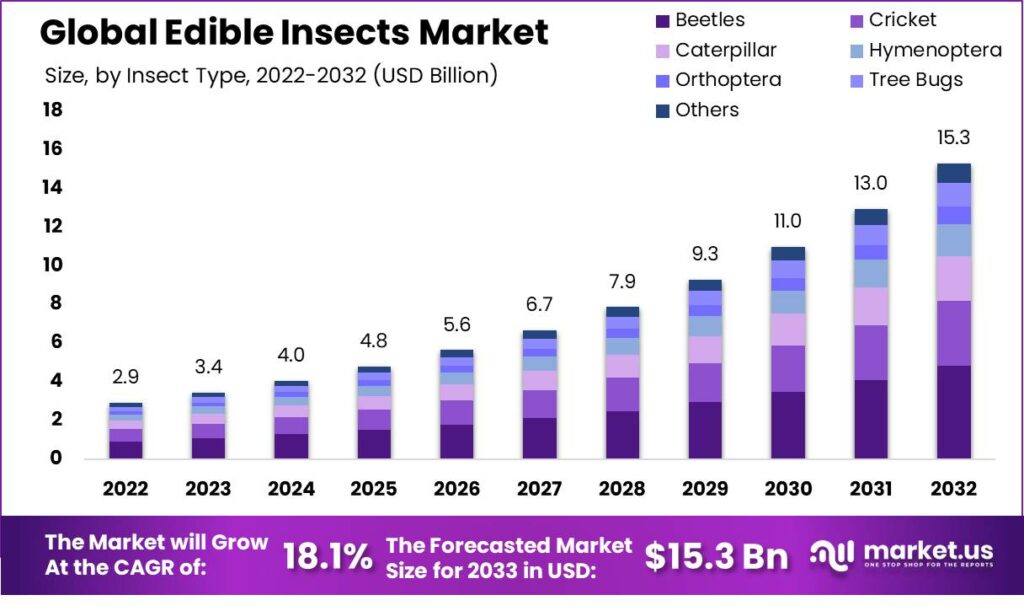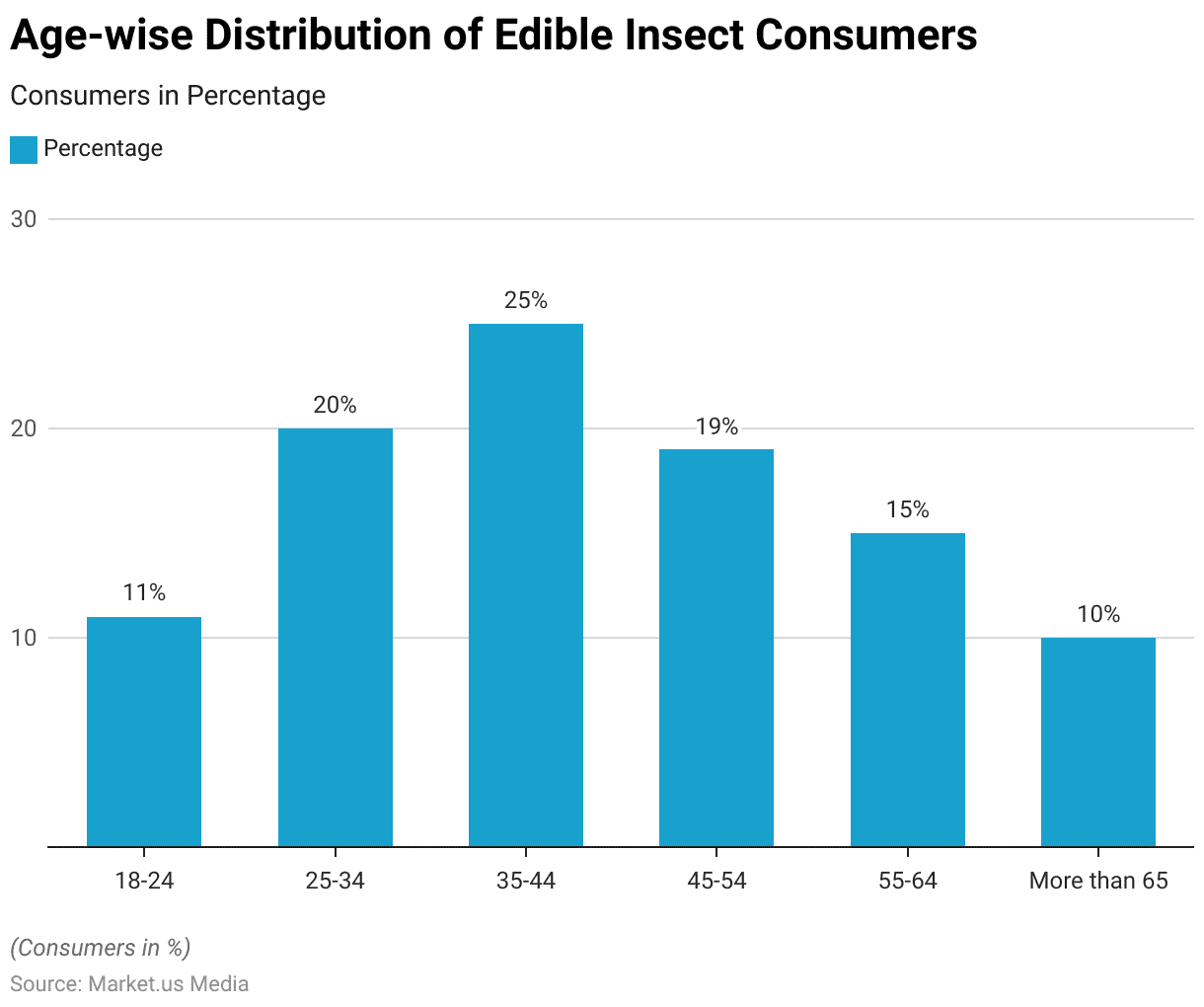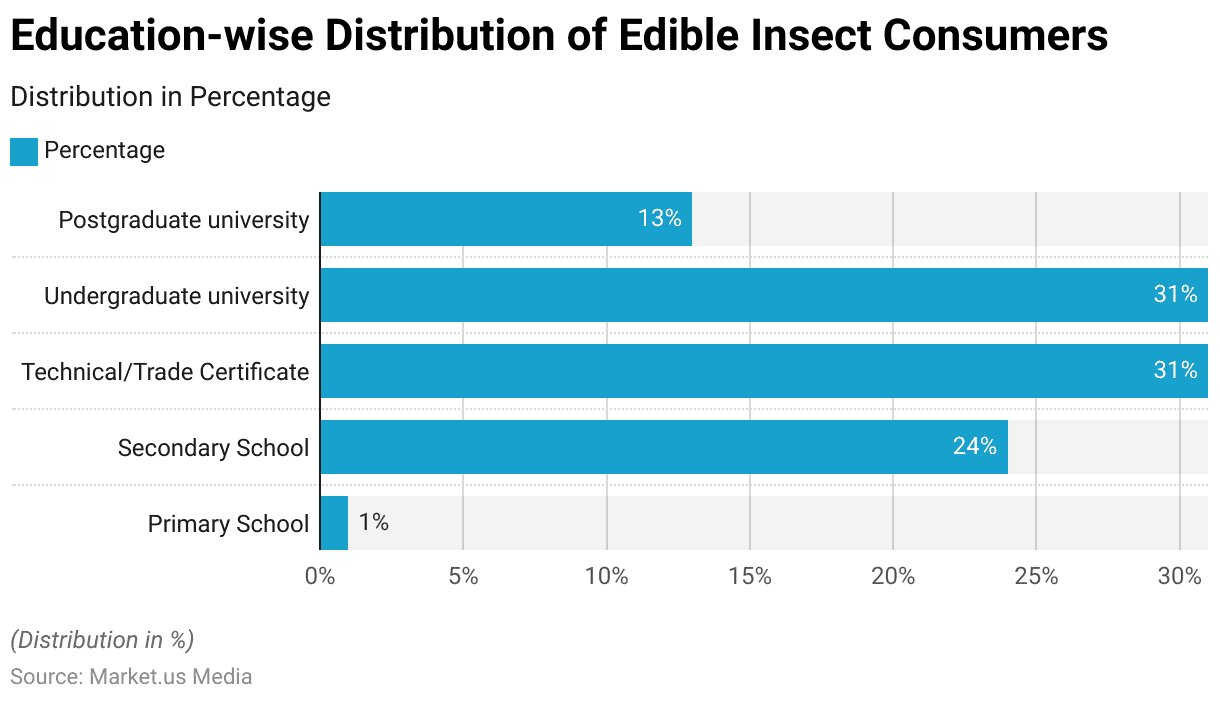Table of Contents
- Introduction
- Editor’s Choice
- Global Edible Insects Market Overview
- Major Groups of Edible Insects
- Number of Insect Species Consumed Around the World
- Demographics of Edible Insect Consumers
- Protein Content of Edible Insects
- Consumers Perspective Regarding Edible Insects
- Consumer Concerns Regarding Edible Insects
- Future Perspectives
Introduction
According to Edible Insects Statistics, Edible insects are gaining favor as a sustainable and nourishing food choice, emerging as a notable trend. Abundant in protein, vitamins, and minerals, they provide an environmentally friendly substitute for conventional livestock farming, requiring less land, water, and feed.
With a history of consumption spanning various cultures over centuries, insects are now entering mainstream diets, driven by growing concerns regarding health and environmental issues.
Despite being at an early stage, the edible insect market displays growth potential, with an array of products like protein bars and snacks hitting the market. As consumers increasingly prioritize health and sustainability, edible insects stand to influence the future landscape of food production and consumption significantly.
Editor’s Choice
- In 2023, the global edible insects market revenue stood at USD 3.4 billion.
- In the Asia-Pacific region, the market experienced a significant decrease from USD 476.9 million in 2018 to USD 173.9 million in 2023.
- Beetles (Coleoptera) dominate the consumption landscape at 31%, followed by caterpillars (Lepidoptera) at 18%.
- The Neotropical region boasts the highest diversity from Mexico to Patagonia, with 725 insect species consumed.
- The 25-34 age group demonstrates a higher participation rate, with 20% engaging in insect consumption.
- The demographics of edible insect consumers reveal a slight gender discrepancy, with males constituting the majority at 55% and females comprising 45% of the consumer base.
- In the United States, approximately 72.5% of surveyed individuals expressed willingness to consume at least one insect-based food product.

Global Edible Insects Market Overview
Global Edible Insects Market Size
- The global edible insects market has exhibited a robust growth trajectory at a CAGR of 18.1%, with revenues steadily increasing.
- In 2022, the market revenue stood at USD 2.9 billion, followed by a notable uptick to USD 3.4 billion in 2023.
- As the acceptance and adoption of edible insects as a sustainable insect protein source continue to expand globally, the market is anticipated to grow substantially, with revenues reaching USD 7.9 billion in 2028, USD 9.3 billion in 2029, and USD 11.0 billion in 2030.
- The market is poised for continued expansion, with revenues projected to surge to USD 13.0 billion in 2031 and USD 15.3 billion in 2032.

Regional Analysis of the Global Edible Insects Market
- The market value of edible insects worldwide varied across regions between 2018 and 2023.
- In the Asia-Pacific region, the market experienced a significant decrease from USD 476.9 million in 2018 to USD 173.9 million in 2023.
- Similarly, Latin America declined from USD 250.6 million in 2018 to USD 92.2 million in 2023.
- Europe also reduced from USD 261.5 million in 2018 to USD 82.1 million in 2023.
- North America experienced a notable decrease from USD 153.9 million in 2018 to USD 44.1 million in 2023.
- Meanwhile, the Middle East and Africa region declined from USD 38.7 million in 2018 to USD 14.2 million in 2023.

Major Groups of Edible Insects
- Edible insects are categorized into major groups, contributing significantly to overall consumption.
- Beetles (Coleoptera) dominate the consumption landscape at 31%, followed by caterpillars (Lepidoptera) at 18%.
- Bees, wasps, and ants (Hymenoptera) collectively account for 14% of consumption, while grasshoppers, locusts, and crickets (Orthoptera) contribute 13%.
- Cicadas, leafhoppers, planthoppers, scale insects, and true bugs (Hemiptera) comprise 10% of the consumption share.
- Termites (Isoptera) and dragonflies (Odonata) each hold a 3% portion, whereas flies (Diptera) represent 2% of consumption.
- The remaining 5% is attributed to other insect varieties.

Percentage of Species Consumed Per Insect Order
- The percentage of species consumed per insect order provides insight into the distribution of insect consumption across various taxonomic groups.
- Coleoptera, comprising beetles, accounts for the most significant portion, with 29.6% of species consumed, reflecting their widespread consumption in diverse culinary traditions.
- Hymenoptera, encompassing bees, wasps, and ants, follows closely behind at 22.2%, indicating their significant role as a food source in many cultures.
- Orthoptera, which includes grasshoppers, locusts, and crickets, contribute 16.9% to the overall consumption, while Lepidoptera, representing caterpillars, make up 16%.
- Hemiptera, consisting of cicadas, leafhoppers, planthoppers, scale insects, and true bugs, account for 11.4% of species consumed, demonstrating their lesser but notable culinary presence.
- Finally, Isoptera, or termites, contribute 3.9% to the total consumption share.

Number of Insect Species Consumed Around the World
- The Neotropical region boasts the highest diversity from Mexico to Patagonia, with 725 insect species consumed.
- In the Oriental region, encompassing Southeast Asia and India, 578 species are consumed, reflecting the rich culinary traditions of these areas.
- Tropical Africa, covering Central and South Africa, follows closely with 470 species consumed, highlighting the significance of insects in local diets.
- In the Palaearctic region, including Europe, North Africa, and China, 294 insect species are consumed, albeit to a lesser extent than other regions.
- The Australasian region, comprising Australia, New Zealand, Papua New Guinea, and the Pacific islands, features 101 species consumed, while the Nearctic region, encompassing the United States and Canada, consumes 95 insect species.

Demographics of Edible Insect Consumers
By Age
- Among consumers aged 18-24, comprising the youngest segment, 11% partake in edible insects.
- The 25-34 age group demonstrates a higher participation rate, with 20% engaging in insect consumption.
- Consumers aged 35-44 represent the most significant demographic, with 25% actively consuming edible insects, indicating a substantial portion of the market.
- In the 45-54 age bracket, 19% of consumers participate in insect consumption, followed by 15% among those aged 55-64.
- Among individuals aged over 65, 10% engage in edible insect consumption.

By Gender
- The demographics of edible insect consumers reveal a slight gender discrepancy, with males constituting the majority at 55% and females comprising 45% of the consumer base.
- This distribution indicates a slightly higher prevalence of edible insect consumption among males than females.
- The predominance of males in insect consumption may stem from various factors such as cultural norms, dietary inclinations, or individual preferences.

Education Level
- The demographics of edible insect consumers, categorized by education level, depict varying levels of engagement across different educational backgrounds.
- Among consumers with a primary school education, participation in edible insect consumption is minimal, accounting for only 1%.
- However, there is a notable increase in consumption among those with secondary school education, with 24% actively engaging in insect consumption.
- The trend continues to escalate among individuals holding technical/trade certificates and undergraduate university degrees, comprising 31% of the consumer base.
- Interestingly, postgraduate university-educated consumers exhibit a slightly lower participation rate at 13%.

Protein Content of Edible Insects
- Blattodea, commonly known as cockroaches, boasts the highest protein content at 68.33%.
- Lepidoptera, encompassing moths and butterflies, follow closely behind with a protein content of 65.25%.
- Orthoptera, including grasshoppers and crickets, demonstrate a substantial protein content of 59.17%, making them a significant protein source.
- Among other insect orders, Hymenoptera, such as bees and ants, exhibit a protein content of 51.43%, while Diptera, which includes flies, showcases a protein content of 48.88%.
- Hemiptera, comprising cicadas and true bugs, demonstrate a similar protein content at 48.83%. Coleoptera, encompassing beetles, present a protein content of 41.75%.

Consumers Perspective Regarding Edible Insects
- In the United States, approximately 72.5% of surveyed individuals expressed willingness to consume at least one insect-based food product.
- By contrast, around 67% of participants in Canada reported having already tried foods containing insects.
- In Denmark, consumers perceive insects as a sustainable food option and a viable meat substitute. Conversely, in Belgium, individuals aged 45 and above demonstrated a greater openness to accepting insect-based foods than other age demographics.
- In a survey conducted as part of the Universitat Oberta de Catalunya (UOC) study on insect consumption, a majority (58%) of respondents believed in the potential for insects to emerge as an alternative and sustainable protein source. Consequently, they envision insects becoming a feasible addition to our diets.
Consumer Concerns Regarding Edible Insects
- Approximately 25% of surveyed adults in the United Kingdom expressed willingness to sample insects, with 30% citing environmental concerns as their primary motivation.
- This percentage was slightly lower than the 34% who indicated they would consume lab-grown meat, with 40% attributing their decision to sustainability and environmental considerations.
- Exactly half of the surveyed individuals believed that edible insects were safe for consumption, compared to 77% who perceived plant-based proteins as safe and only 30% who felt the same about lab-grown meat.
- However, a significant portion (67%) expressed unwillingness to try edible insects, while 13% stated they could be convinced if assured of safety and 11% if the insects appeared appetizing.
Future Perspectives
- Despite initial reluctance, attitudes toward insect consumption can improve under specific circumstances.
- Nearly half of the respondents (approximately 50%) expressed that access to information regarding the sustainability of insect-based food could positively influence their willingness to consume it, while 48% disagreed.
- Additionally, respondents emphasized the importance of preparing insects for consumption, with 70% indicating that disguising insects’ natural appearance would enhance their appeal.
- Conversely, 10% believed showcasing insects naturally could make them more appealing.
- Among the preferred formats for insect consumption, flour emerged as the most popular choice (23%), followed by biscuits (6%) and bars (5.8%).
Discuss your needs with our analyst
Please share your requirements with more details so our analyst can check if they can solve your problem(s)



